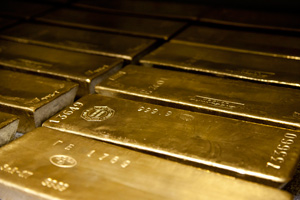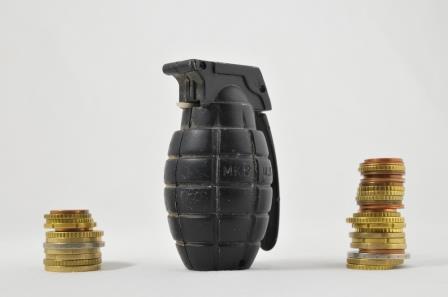by Peter Krauth •
This is a syndicated repost courtesy of Money Morning. To view original,click here.
Germany, Poland, Venezuela, Ecuador, Mexico, the Netherlands, and Switzerland are just a few of the countries that have recently repatriated their gold or hosted movements to do so.
And now France joins the list.
This growing trend provides a clue about gold in 2015 – and we’d be wise to track it very carefully…
Netherlands Repatriates 122 Tons of Its Gold
The Netherlands’ central bank, De Nederlandsche Bank (DNB), recently had 122 tons of its gold shipped to Amsterdam from New York.
 According to DNB, 31% of its gold reserves are now held in Amsterdam, with the rest held outside of the country. About 31% is with the Federal ReserveBank of New York, 20% is with the Bank of Canada, and 18% is with the Bank of England.
According to DNB, 31% of its gold reserves are now held in Amsterdam, with the rest held outside of the country. About 31% is with the Federal ReserveBank of New York, 20% is with the Bank of Canada, and 18% is with the Bank of England.
Here’s what’s really interesting about the repatriation of Holland’s gold: It was only made public after the fact.
It’s possible that Holland wants to prepare in advance of a potential future crisis.
In a recently released statement, the DNB said, “In addition to a more balanced division of the gold reserves… this may also contribute to a positive confidence effect with the public.”
And Holland is not alone.
As I discussed recently, the Swiss gold referendum held last Sunday did not pass. In fact, a large and concentrated campaign against the initiative was mounted by both the government and central bank.
Their main arguments were that the conditions of the initiative would tie the SNB’s hands, constraining its ability to maintain its current peg to the euro and to weaken the franc against other currencies should it be deemed necessary.
Although it didn’t pass, the referendum may have had a profound effect on people, governments, and their central banks – and how they view their nation’s gold.
The push to repatriate and shore up Switzerland’s gold reserves looks to have inspired its neighbor France to bring home its own gold.
Here’s why this is so remarkable – and what it means for gold in 2015…
French Leader Calls for Gold to Come Home
Marine Le Pen is the leader of the Front National party of France, which finished first in European parliamentary elections this past May.
While the next federal election is still only set for 2017, should she run, Le Pen is a frontrunner to become France’s next president, potentially unseating current President Francois Hollande.
Given Le Pen’s popularity, her recent requests regarding France’s management of its gold reserves are all the more remarkable.
In an open letter to the Banque de France (France’s central bank), Le Pen made several demands that closely echo those of the Swiss initiative.
Her letter to Christian Noyer, the governor of Banque de France, demanded that all the country’s gold reserves be repatriated:
The monetary institution that you lead has historically served as the reserve central bank for France’s monetary and gold reserves. In our strategic and sovereign vision, these do not belong to the state, nor the Bank of France, but to the French people, which serve as the ultimate guarantee of public debt and our money.
But she did not leave it at that. Le Pen raised several of the same issues as the Swiss initiative, and even some of her own.
As leader of the Front National, she asked the Banque de France to urgently repatriate all the nation’s gold reserves located abroad, end all gold sales programs, and progressively move foreign exchange reserves into more gold by buying during marked price declines (around 20% recommended).
She went further still, asking for a complete inventory of the nation’s physical gold and its quality (purity and serial numbers). She asked for an independent audit and inventory, indicating where gold reserves are stored both in France and abroad.
Le Pen also requested that any gold loans or leases by the central bank be made public. She further stated that France’s sale of 615 tonnes of gold from 2004 to 2012 was costly, constitutes a serious violation of the national heritage, and was made without democratic consultation.
Why Gold in 2015 Will Move Higher
In early 2013 Germany asked for a large portion of its gold back from the New York Fed. It’s a slow process that’s running behind schedule, prompting many to doubt whether the Fed even has all the gold it purports.
After all, it’s a relatively simple task. Even worse, the Fed has refused Germany’s requests to audit its gold.
I’ll leave you to draw your own conclusions on that one.
People and governments are starting to wake up to the idea that gold has always been the ultimate form of insurance.
In the last several years we’ve witnessed more than our fair share of crises.
With that kind of backdrop, it’s little wonder the push to repatriate national gold reserves is growing ever stronger.
And that’s yet another reason the outlook for gold in 2015 remains very bright. Gold priceswill be heading higher.
More from Peter Krauth: Switzerland’s historic gold referendum failed after some strong campaigning, with 78% voting against the initiative. A “yes” vote would have been bullish for gold. But despite the “no” vote, gold prices rose anyway. Here’s why gold moved higher after the Swiss vote – and why we are bullish on gold into 2015…
The post Gold in 2015: What the Gold Repatriation Movement Tells Us appeared first on Money Morning
http://wallstreetexaminer.com/2014/12/gold-in-2015-what-the-gold-repatriation-movement-tells-us/








